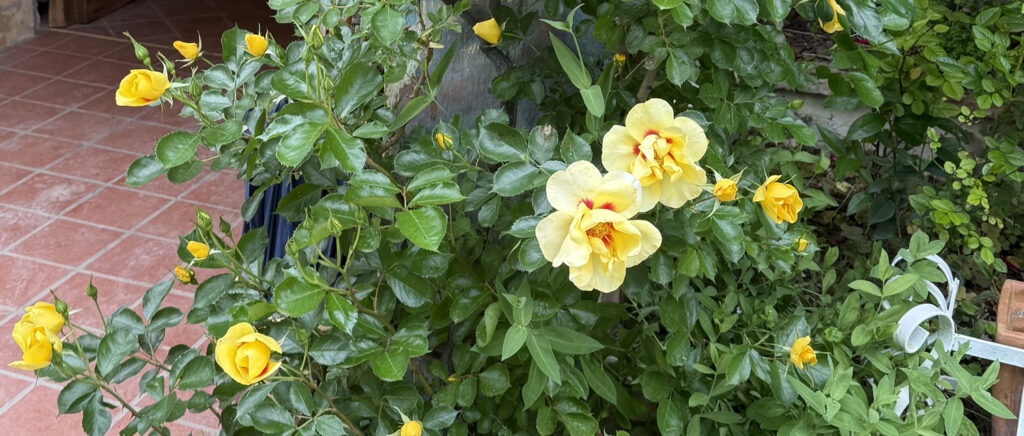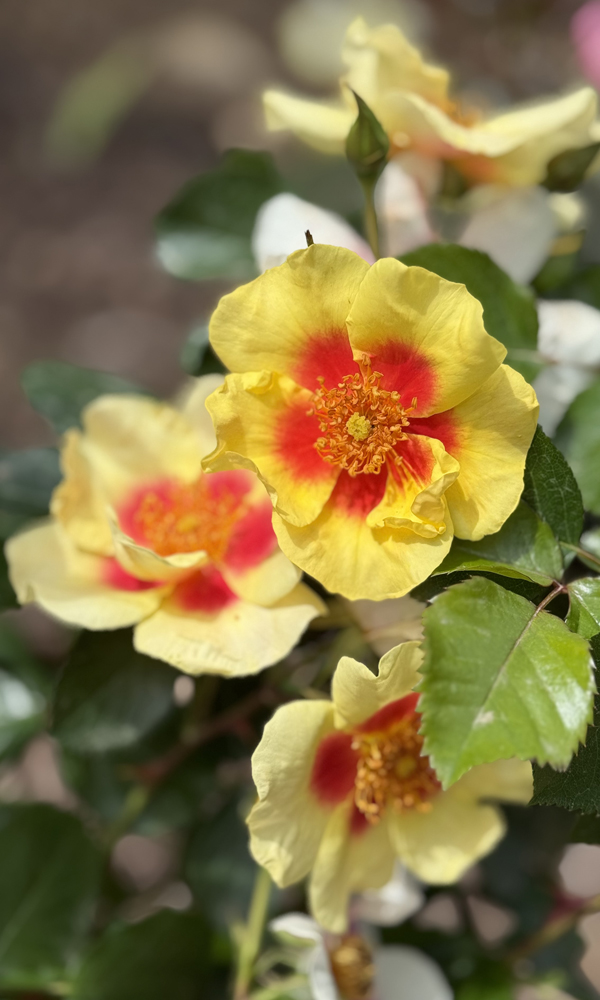Rosa persica hybrids – Rosiers Hulthemia
The Orient at the heart of the rose
L’Orient au cœur de la rose

Click on the images to enlarge them / Cliquez sur les images pour les agrandir
It was during an MGF visit to the Mas du Chambon in April 2025 that I became inspired to write this article. During the tour, the group was intrigued by the sight of a yellow rose with a deep burgundy centre—a modern cultivar of the Hulthemia rose, recognisable by the distinctive central blotch, similar to certain cistus flowers.
C’est à l’occasion d’une visite du groupe MGF au Mas du Chambon à Lunel, en avril 2025, que j’ai eu l’idée d’écrire cet article. Lors de cette sortie, les participants ont été intrigués par un rosier jaune au cœur rouge bordeaux, un cultivar moderne issu du rosier Hulthemia. Ce dernier se reconnaît facilement à la tache pourpre centrale sur ses pétales, évoquant certaines espèces de cistes.
I have grown this unique variety in my garden in all its forms and colours—from compact bushes to vigorous climbers, with both single and double blooms, in shades of yellow, pale yellow, pink, and salmon. The flowers, marked with the famous burgundy blotch in the center, have a charm I personally find fascinating.
Je cultive depuis plusieurs années cette variété dans mon jardin, sous toutes ses formes et dans de nombreuses couleurs : buissons compacts, grimpants vigoureux, floraisons simples ou doubles, dans des teintes de jaune, rose, saumon ou crème. Toutes ont en commun cette fameuse tache centrale bordeaux, que je trouve personnellement fascinante.
These roses are still relatively rare in French nurseries. People either love them, or are indifferent to them, there is no in-between. Yet, their resilience is remarkable. Thanks to their origins in arid lands, they withstand drought, resist disease, and adapt easily to poor soils.
Ces rosiers restent encore rares en jardinerie française. C’est une rose que l’on adore ou que l’on délaisse, mais qui ne laisse jamais indifférent. Pourtant, sa robustesse est remarquable. Issue de milieux arides, elle résiste bien à la sécheresse, aux maladies, et s’accommode de sols pauvres.
I have ordered many bare-root specimens from a Dutch rose grower and grown them in my garden. I’ll share contact details at the end of this article. The plants always arrived in excellent condition—I’ve never lost a single one.
J’en ai commandé de nombreux exemplaires — toujours en racines nues — auprès d’un excellent rosiériste basé aux Pays-Bas, dont je vous donnerai les coordonnées à la fin de cet article. Tous les plants sont arrivés en parfait état, et je n’en ai jamais perdu un seul.
Among the many rose lineages, few have as unique a story as the Hulthemia. Native to the desert regions of Central Asia (Iran, Afghanistan, Turkmenistan), this wild species is notable for the dark blotch at the base of each petal, forming a characteristic central ‘eye’.
Parmi les nombreuses lignées de rosiers, peu ont une histoire aussi singulière que celle des Hulthemia. Originaire des régions désertiques d’Asie centrale (Iran, Afghanistan, Turkménistan), cette espèce sauvage se distingue par une tache sombre à la base de chaque pétale, formant un « œil » central très caractéristique.
In 1784, André Michaux, a French botanist sent by King Louis XVI, discovered this yellow rose with burgundy markings in the Zagros Mountains (on the Iran-Iraq border). He named it Hulthemia persica—also known as Rosa persica or Hulthemia berberifolia (sometimes classified under the Pimpinellifoliae group). Seeds were brought back to France.
C’est en 1784 qu’André Michaux, botaniste envoyé par Louis XVI, découvre ce rosier aux fleurs jaunes marquées de bordeaux dans les monts Zagros (à la frontière irano-irakienne). Il le nomme Hulthemia persica, également connu sous les noms de Rosa persica ou Hulthemia berberifolia (parfois rattaché au groupe des Pimpinellifoliae). Des graines sont rapportées en France.
In 1786, Alexandre Hardy, director of the Jardin du Luxembourg, obtained one of the first hybrids, Hulthemia × hardii, in honor of Belgian bibliophile Charles Van Hulthem, co-founder of the Ghent Botanical Garden.
En 1786, Alexandre Hardy, directeur du Jardin du Luxembourg, obtient l’un des tout premiers hybrides : Hulthemia × hardii, dédié à Charles Van Hulthem, bibliophile belge et cofondateur du jardin botanique de Gand.
For nearly two centuries, the rose remained a botanical curiosity, with no real horticultural use.
Pendant près de deux siècles, cette rose demeure une curiosité botanique sans réel développement horticole.
In the 1960s, British breeder Jack Harkness began hybridising this unusual rose. He produced the first commercial Hulthemia hybrids, such as Tigris, Euphrates, and Nigel Hawthorne. These varieties had one major flaw: they did not bloom continuously, something that was very much in fashion at the time.English text
Il faut attendre les années 1960 pour voir Jack Harkness (Angleterre) entamer un travail de sélection. Il crée alors les premiers rosiers commerciaux issus de Hulthemia : Tigris, Euphrates, Nigel Hawthorne… Ces variétés avaient toutefois un inconvénient majeur pour l’époque : elles ne fleurissaient pas de manière continue, ce qui allait à l’encontre des tendances horticoles de l’époque.
Then, Jim Sproul*, a passionate Californian scientist and amateur rose breeder, based in Bakersfield, heard about the British hybrids. He too was working on new varieties of Hulthemia. He identified the genetic link between the signature blotch and the non-reblooming trait. Thanks to advances in genetics, he found a way to eliminate the limitation.
C’est alors qu’intervient Jim Sproul*, un passionné californien basé à Bakersfield. Scientifique de formation, il consacre son temps libre à l’hybridation des rosiers, notamment les Hulthemia. Il identifie le lien génétique entre la fameuse tache centrale et le caractère non remontant des premières variétés. Grâce aux progrès de la génétique, il parvient à surmonter cet obstacle.
In 2011, he launched a series of continuously blooming Hulthemia roses: the Eyeconic collection (Eyeconic Lemonade, Eyeconic Pink Lemonade, etc.).
En 2011, il lance la série Eyeconic, à floraison continue : Eyeconic Lemonade, Eyeconic Pink Lemonade, etc.

During the same period, in the UK, Christopher H. Warner developed some superb varieties such as Peter’s Persica (Chewgoldeye), Eye of the Tiger (Chewbullseye), For Your Eyes Only (Cheweyesup), Angel Eyes (Chewdelight), Smiling Eyes (Chewrocko), among others.
De son côté, Christopher H. Warner (Royaume-Uni) développe de magnifiques variétés, telles que Peter’s Persica (Chewgoldeye), Eye of the Tiger (Chewbullseye), For Your Eyes Only (Cheweyesup), Angel Eyes (Chewdelight), ou encore Smiling Eyes (Chewrocko). D’autres suivront.

These cultivars are all known for their generous flowering, healthy foliage, elegant shape, and exceptional drought tolerance.
Toutes ces roses sont réputées pour leur floraison abondante, leur feuillage sain, leur port harmonieux et leur grande tolérance à la sécheresse.
In 2020, German nursery Tantau introduced Rosa persica ‘Orienta Magnolia’, with semi-double pale pink blooms and a magenta centre. New hybrids with double flowers, and both miniature and climbing roses continue to appear throughout Europe and beyond.
En 2020, la maison Tantau (Allemagne) lance Rosa persica ‘Orienta Magnolia’, une variété à fleurs semi-doubles blanc rosé au cœur magenta. Des hybrides toujours plus variés, aux fleurs parfois doubles, grimpantes ou miniatures, continuent de voir le jour en Europe et ailleurs.
Hulthemia roses are perfectly suited to Mediterranean gardens. Their desert origin makes them naturally resistant to prolonged droughts, undemanding in terms of soil, and rarely affected by disease. They offer generous flowering from spring to the first frost. For those who love architectural, unusual plants, this is a rose worth discovering.
Les Hulthemia sont parfaitement adaptés aux jardins méditerranéens. Leur origine désertique leur confère une excellente résistance à la sécheresse, une faible exigence en sols, et une bonne tolérance aux maladies. Leur floraison généreuse dure du printemps jusqu’aux premières gelées. Pour les amateurs de plantes graphiques et peu communes, c’est un rosier à découvrir absolument.
A recommended supplier
I highly recommend the Dutch rose nursery Rozen Lottum, which offers a wide selection of Hulthemia roses at very reasonable prices. I order bare-root plants in winter to avoid high shipping costs.
Un bon fournisseur
Je recommande sans réserve le rosiériste Rozen Lottum, aux Pays-Bas. Il propose une belle sélection de rosiers Hulthemia à des prix très raisonnables. Je passe mes commandes en racines nues durant l’hiver, ce qui limite considérablement les frais de port.
*Jim Sproul blog ‘Rose hybridizing’
Text and photos : Jacqueline Potter
![]()


